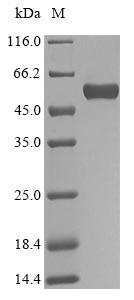Delve into the world of signal transduction with our premium Recombinant Human BGN protein, an essential component of the extracellular matrix. Biglycan, also known as bone/cartilage proteoglycan I or PG-S1, is a small leucine-rich proteoglycan that plays a pivotal role in regulating cell adhesion, growth, and differentiation. Its involvement in key cellular processes and interactions makes it a valuable protein for researchers exploring signal transduction pathways and related mechanisms.
Our Recombinant Human BGN protein is expressed in E. coli, ensuring a high-quality and robust product. It spans the full length of the mature protein, covering the 38-368aa region, retaining the essential functional domains for your experimental needs. The N-terminal 10xHis-SUMO tag and C-terminal Myc tag facilitate efficient protein purification and detection, simplifying your workflow. With a purity greater than 90% as determined by SDS-PAGE, our Recombinant Human BGN protein is provided as a lyophilized powder, offering you a reliable and consistent tool for your signal transduction research projects.




